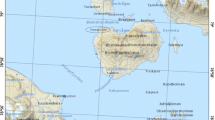Abstract
The effect of solar radiation, especially the ultraviolet regime (UVA and UVB), has been examined on Daphnia pulicaria (Forbes) in a subarctic lake. Daphnia were exposed to four radiation regimes: total radiation, exclusion of UVB, exclusion of UVA and UVB and dark controls. Exposure lasted 2–4 days in 2 depths (8 cm and 24 cm). In the subsurface (8 cm) exposure survival was significantly increased when UVB or UVB and UVA were excluded. In addition, the percentage of egg carrying Daphnia and the number of live offspring increased significantly when UVB was excluded. In 24 cm depth, an increase of survival was noticeable only in some of the experiments. Differences in reproduction due to different radiation regimes, too, were not significant. The results demonstrate that not only UVB, but UVA also may have a significant effect on Daphnia in their natural habitat.
Similar content being viewed by others
References
Blumthaler, M. & W. Ambach, 1992. Indication of increasing solar ultraviolet-B radiation flux in Alpine regions. Science 248: 206–208.
Damkaer, D. M., D. B. Dey, G. A. Heron & E. F. Prentice, 1980. Effects of UV-B radiation on near-surface zooplankton of Pudget Sound. Oecologia 44: 149–158.
Delange, M. & E. Vandonk, 1997. Effects of UVB-irradiated algae on life history traits of Daphnia pulex. Freshwater Biology 38: 711–720.
Hebert, P. D. N. & C. J. Emery, 1990. The adaptive significance of cuticular pigmentation in Daphnia. Functional Ecology 4: 703–710.
Hessen, D. O., 1994. Daphnia responses to UV-light. Arch. Hydrobiol. Beih. 43: 185–195.
Hessen, D. O., 1996. Competitive trade-off strategies in Arctic Daphnia linked to melanism and UV-B stress. Polar Biology 16: 573–579.
Hunter, J. R., S. E. Kaupp & J. H. Taylor, 1981. Effects of solar and artificial ultraviolet-B radiation on larval northern anchovy, Engraulis mordax. Photochem. Photobiol. 34: 477–486.
Jokela, K., K. Leszczynski, R. Visuri & L. Ylianttila, 1995. Increased UV exposure in Finland in 1993. Photochem. Photobiol. 62: 101–107.
Jüttner, I., 1989. Untersuchungen zur UV-Toleranz von Daphnia pulex obtusa unter besonderer Berücksichtigung verschiedener Populationsparameter. Master Thesis, Department of Zoology, Ludwig-Maximilian-University, Munich, Germany.
Karanas, J. J., R. C. Worrest & H. Van Dyke, 1979. Impact of UV-B radiation on fecundity. Mar. Biol. 65: 125–133.
Luecke, C. & J. W. O'Brien, 1983. Photoprotective pigments in a pond morph of Daphnia middendorffiana. Arctic 36: 365–368.
Lurling, M. & E. Vandonk, 1997. Life histoty consequences for Daphnia pulex feeding on nutrient-limited phytoplankton. Freshwat. Biol. 38: 693–709.
Siebeck, O. & U. Böhm, 1994. Challenges for an appraisal of UVB effects upon planktonic crustaceans under natural radiation conditions with a non-migrating (Daphnia pulex obtusa) and a migrating cladoceran (Daphnia galeata). Arch. Hydrobiol. Beih. 43: 197–206.
Smith, R. C., B. B. Prezelin, K. S. Baker, R. R. Bidigare, N. P. Boucher, T. Coley, D. Karentz, S. McIntyre, H. A. Matlick, D. Menzies, M. Ondrusek, Z. Wam & K. J. Waters, 1992. Ozone depletion: ultraviolet radiation and phytoplankton biology in Antarctic waters. Science 255: 952–959.
Williamson, C. E., H. E. Zagarese, P. C. Schulz, B. R. Hargreaves & J. Seva, 1994. The impact of short-term exposure to UV-B radiation on zooplankton communities in north temperate lakes. J. Plankton Res. 16: 205–218.
Zagarese, E., C. E. Williamson, M. Mislivets & P. Orr, 1994. The vulnerability of Daphnia to UV-B radiation in the Northeastern United States. Arch. Hydrobiol. Beih. 43: 207–216.
Zellmer, I. D., 1993. Der Einfluß des Futters auf die UV Toleranz von Daphnia pulex unter Labor-und Freilandbedingungen. PHD. Thesis, Ludwig-Maximilians-Universität Munich.
Zellmer, I. D., 1995. UV-B-tolerance of alpine and arctic Daphnia. Hydrobiologia 307: 153–159.
Zellmer, I. D., 1996. The impact of food quantity on UV-B tolerance and recovery from UV-B damage in Daphnia pulex. Hydrobiologia 319: 87–92.
Rights and permissions
About this article
Cite this article
Zellmer, I.D. The effect of solar UVA and UVB on subarctic Daphnia pulicaria in its natural habitat. Hydrobiologia 379, 55–62 (1998). https://doi.org/10.1023/A:1003285412043
Issue Date:
DOI: https://doi.org/10.1023/A:1003285412043




